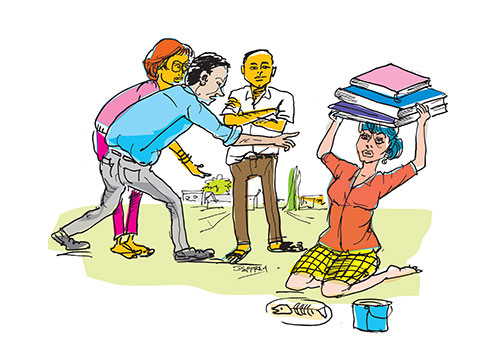by Ahilan Kadirgamar
Free education is one of the strongest pillars of our society. In this column, I address the consequences for the education sector, after Sri Lanka’s first-ever default on its external debt and the IMF’s arbitration of debt restructuring with the country’s external creditors.
Sri Lanka defaulted only on its external debt in April 2022 due to the lack of foreign exchange for debt-servicing. However, debt restructuring with the IMF has entailed restructuring of not just external debt but also the fiscal budget dependent mainly on domestic debt in local currency. The intentional conflation by the neoliberal establishment of these two different domains is to ensure the external creditors are repaid their loans through higher taxes or lowered public expenditure. In this way, the ‘twin deficits’ – one, the current account consisting of external debt in foreign currency for which foreign earnings should be more than imports; and two, the fiscal deficit that is addressed by domestic debt in local currency when government expenditure exceeds revenues, over which the government has more control as it can borrow locally in rupees – is pushing the country into an abyss of austerity and suffering.
In the driving seat of this conflation and policies to address the twin deficits is the IMF supported by the World Bank. The ongoing IMF programme and the World Bank Country Partnership Framework are shaping Sri Lanka’s public spending and economic policy trajectory. In the education sector, they are determining the funds allocated for education, both recurrent expenditure necessary mainly to pay decent wages, and capital investment in buildings, facilities and other development activities to ensure that educational institutions will be able to meet the needs of the sector in future years. The austerity measures associated with the IMF programme and the push for commercialisation are weakening free education.
Priorities and cuts
The IMF Agreement that Sri Lanka signed onto in March 2023 is reflective of the manner in which any such programme is two faced. While the IMF claims to be concerned about the impact of the crisis on the people, its macroeconomic program sets conditions that reflect a different logic.
The President of Sri Lanka and the Central Bank Governor in the Memorandum of Economic and Financial Policies have agreed to the following with the IMF:
“We will reinforce the primarily revenue-based fiscal consolidation with expenditure rationalisation, while preserving spending on priority areas. To contain recurrent expenditure, we will develop strategies to limit growth in the public sector wage bill and public pension spending, while avoiding salary cuts and allowing for limited public sector salary and public pension payment increases to partially account for inflation during the program within the program’s primary balance targets. Given fiscal space constraints on capital expenditure, we will take measures to boost public investment efficiency, as recommended by the 2018 IMF Public Investment Management Assessment. While expenditure rationalisation will contribute to fiscal consolidation, we will preserve spending on health, education, and social protection.” Pg 89, IMF Agreement, March 2023
This pledge to “preserve spending on health, education” as well as “[avoid] salary cuts” while ensuring “expenditure rationalisation” contributing to “fiscal consolidation” is contradictory, as it is claiming to both maintain and cut spending at the same time. This is characteristic of the rhetoric in most IMF programmes.
The IMF-led austerity programme, despite many promises to preserve social spending, inevitably lead to cuts in the real value of social spending, as reflected in the recently released Finance Ministry Annual Report for 2023. Between 2021 and 2023 the cost of living in Sri Lanka increased by one hundred percent, or if we look at it in dollar terms, the value of the Sri Lankan rupee declined by fifty percent from Rs 200 to Rs 300 per dollar. However, during this period increase in the nominal spending for general education was only 22.5% and for higher education was a mere 13.1%.
IMF programmes work towards fiscal consolidation by inflating away social spending, which means the real value of such spending reduces as a percentage of GDP. This year there have been marginal increases in the salaries of university teachers after their struggle, and the non-academic staff are in the midst of a major struggle to gain a raise in salary. While such demands for salary increases are justified, particularly given the massive rise in cost of living, any salary increase will only come from existing allocations, as the allocation for university education cannot be increased as per the IMF programme. In other words, other spending, including capital expenditure, on universities are reduced to accommodate such increases in salaries, as has been the case with the raise received by university teachers.
Defunding and privatisation
The straitjacket of the IMF programme and the Government’s strategy are to defund education and pave the way for privatisation, so that the Government can allocate even less for education as well as allow for private extraction from education. For instance, universities are increasingly being pushed to earn their funds with fee-levying programmes undermining the free education policy. This great shift away from free education affecting state universities will soon make its way into general education. What J.R. Jayewardene and his open economy policies coupled with the IMF-World Bank Structural Adjustment Program could not achieve since the 1980s, is now being promoted by the Government claiming there is no other way to reach debt sustainability.
For decades, Sri Lanka has been reducing its spending on education. In fact, expenditure on education has spiralled downwards over the decades from close to 5% of GDP in 1970 to 1.2% in 2022, one of the lowest today in the world. Nevertheless, Sri Lanka has remained one of the last bastions of free education all the way up to the tertiary level. The current crisis along with the IMF stranglehold has finally given the IMF, the World Bank and the comprador Sri Lankan elite nexus, opportunities to make education both the privilege of the wealthy and a money-making commercial enterprise.
What is to be done? The intelligentsia has the challenge before them to show how debt sustainability while ensuring social welfare can only be achieved with much larger cuts to the external debt stock, particularly by reducing or cancelling the debt owed to bondholders who have already extracted a large amount of wealth in the form of high interest payments from Sri Lanka. In other words, we must work on our own Debt Sustainability Analysis (DSA) to delegitimize the IMF’s DSA crafted in the interest of creditors and global financial interests. Such concerns must be infused into the upcoming election debates so as to change the economic policy trajectory after the elections. The public must build great barriers out on the streets, in other words protests to stop the slide towards commercialisation of education, as well as demand that the government drastically increase the allocation for education, including through of redistribution with wealth taxes.



